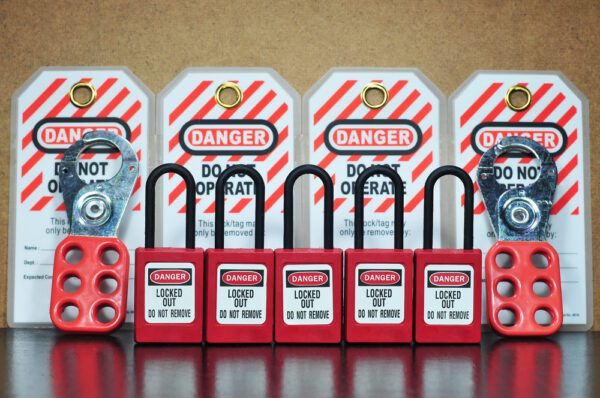
When energized equipment needs maintenance, sometimes turning it off is not enough. Lockout/tagout protects maintenance workers against the unexpected release of hazardous energy or asset startup during maintenance activities. This article provides an overview of lockout/tagout and its significance to maintenance.
What is Lockout/Tagout?
Lockout/tagout (LOTO) is a safety procedure related to the control of hazardous energy, as laid out by the Occupational Safety and Health Administration (OSHA) standard Title 29 CFR Part 1910.147. This standard covers “the servicing and maintenance of machines and equipment in which the unexpected energization or start up of the machines or equipment, or release of stored energy could cause injury to employees.” Organizations comply with this regulation by establishing and carrying out procedures that ensure equipment is disconnected from its energy source, and stored energy is released, prior to performing maintenance.
Why Lockout/Tagout is Important
Maintaining and operating energized systems has the potential to expose employees to hazardous energy which, if uncontrolled, can cause serious injury or death. Lockout/tagout procedures were created to protect maintenance technicians, machine operators, and others from such outcomes.
OSHA estimates that 120 fatalities and 50,000 injuries are prevented each year thanks to compliance with the LOTO standard. Despite the importance of lockout/tagout, LOTO compliance is one of the most frequently cited workplace safety standard violations (as of 2021).
What Different Forms can Hazardous Energy Take?
The lockout/tagout standard identifies the following types of hazardous energy:
- Electrical: The primary energy source for most equipment.
- Mechanical: Energy created through motion and moving parts.
- Hydraulic: Energy created through pressurized liquid and especially useful for heavy machinery.
- Pneumatic: Energy created through pressurized air, commonly used in materials handling and packaging applications.
- Chemical: Energy created through chemical reactions.
- Thermal: Energy created through the release of heat from sources including steam, natural gas, oil, nuclear, and biomass.
- Other: Any other types of energy not already covered.
How Lockout/Tagout Works

As its name implies, a lockout/tagout procedure utilizes both locks and tags. Lockout devices, such as padlocks or hasps, physically keep equipment in an “off” or safe state by holding energy-isolating devices in place. Tagout devices provide visible warnings that inform employees of hazards and indicate equipment may not be used.
When Lockout/Tagout Standards Apply
Generally, lockout/tagout applies any time the unexpected release of energy could harm someone. However, OSHA outlines certain exceptions. During normal production operations, LOTO applies only if:
- An employee is required to remove or bypass a guard or other safety device (also refer to the Title 29 CFR Part 1910.212 standard)
- An employee is required to place any part of his or her body into an area on a machine or piece of equipment
The LOTO standard does not apply to:
- Minor tool changes, adjustments, and other minor servicing activities which take place during normal production operations
- “Routine and repetitive” maintenance activities in which employees are not putting their bodies in harm’s way
- Cord and plug-connected electric equipment for which energy is controlled by unplugging the equipment and the plug is in exclusive control of the person performing maintenance
- Hot tap operations involving the transmission and distribution of gas, steam, water, etc, when service is necessary, the system cannot be shutdown, and employees are protected in some other way
In addition, the 1910.147 lockout/tagout standard does not apply to the following industries:
Organizations in each of these industries are required to comply with other industry-specific standards regarding the control of hazardous energy. Refer to the OSHA website for more information.
| Disclaimer: While we make every effort to keep information up to date and accurate, compliance requirements are subject to change without our knowledge. Your organization holds responsibility for verifying any information discussed in this article with official sources before applying it to your organization. Please review the disclaimer in our Terms and Conditions for more information. |
What are the 6 Steps of Lockout/Tagout?
The OSHA standard provides minimum requirements for controlling hazardous energy, but provides flexibility for organizations to develop their own lockout/tagout procedures. The lockout/tagout steps below are generally applicable regardless of industry. It assumes that the required personnel have been trained in LOTO procedures.
- Preparation: Have an authorized employee, who has a complete understanding of all types of hazardous energy that must be controlled, identify energy sources and the means to control them. Notify all employees who might be affected by lockout/tagout that the equipment will be shut down for maintenance.
- Shut Down: Shut down equipment using its normal stopping procedure.
- Isolation: Isolate equipment from its hazardous energy source.
- Lockout/Tagout: Have an authorized employee attach locks and tags to each energy-isolating device so that it stays in a “safe” position.
- Check for Stored Energy: Look for any stored or residual hazardous energy and release, restrain, dissipate, or disconnect it.
- Verify Isolation: Verify that the equipment is isolated from its energy source, locked and tagged out, and de-energized. The equipment is now ready for servicing or maintenance.
Lockout/Tagout and Maintenance Safety
Lockout/tagout procedures help you meet regulatory requirements and, more importantly, keep maintenance technicians (and others) safe. Maintenance organizations ensure compliance with lockout/tagout standards by tracking LOTO procedures in their computerized maintenance management system (CMMS) software.
CMMS software stores lockout/tagout documentation, making it readily accessible to maintenance employees. LOTO instructions can be included on work orders, reminding technicians of the necessity for lockout/tagout. When maintenance audits occur, the CMMS provides documentation that LOTO procedures were followed.
Improve Safety with FTMaintenance Select
At times, maintenance technicians are put into potentially dangerous environments. FTMaintenance Select improves workplace safety by storing critical maintenance documentation like lockout/tagout procedures alongside their related asset records and work orders. Request a demo today to learn more about how FTMaintenance Select can help you comply with maintenance safety standards.